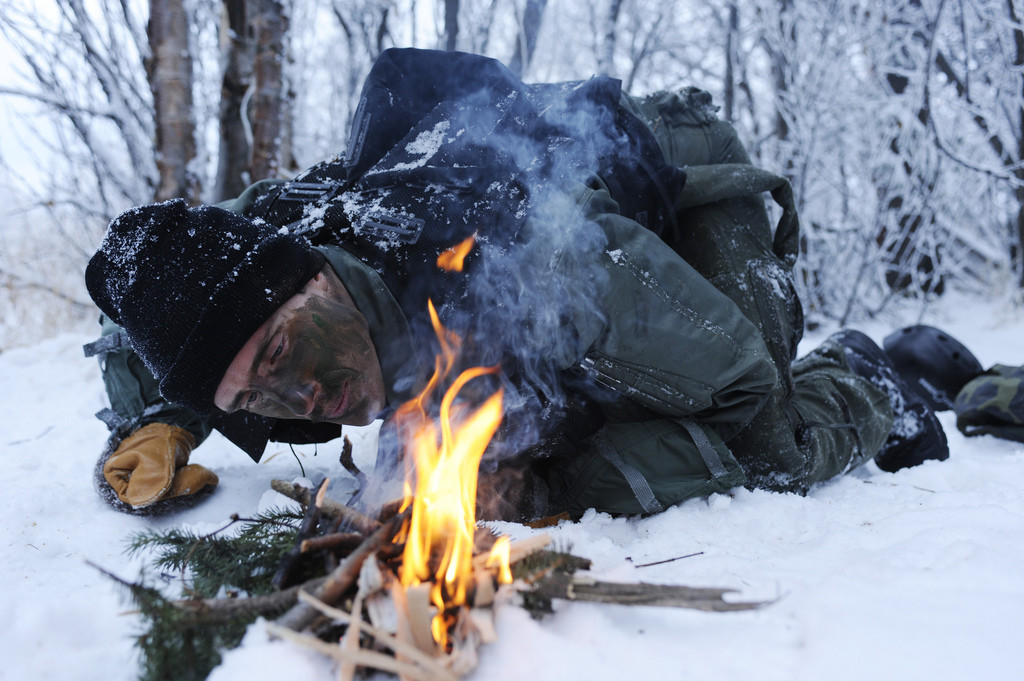If you’re stuck in the wilderness and you haven’t brought supplies, making fire with a friction technique becomes the ultimate survival skill. Once you master it, you’ll have fire wherever life takes you. (Assuming life doesn’t take you to a lot of crowded theaters or fire safety presentations. Then you’ll probably need to hire a good lawyer.)
No matter what friction technique you use, you’ll need a fire board, a spindle, and a socket. And though it may seem simple, here’s our survival guarantee: if you don’t learn your stuff, you’ll be cursing late into a dark, cold night.
Here’s a guide to making a fire board, spindle, and socket – how it works, what wood to use, how to make it right, and how to use it when you’re done.
How It Works
At its most primitive, a friction technique requires only a spindle and a fire board. Friction is created by spinning the spindle repeatedly against the board. While this technically counts as a survival skill, it will take you roughly a year and one day and result in hands so blistered that your pus could fill a small juice glass.
Using a socket, which is then partnered with some sort of turning mechanism, enables you to rotate the spindle more quickly and protect your hands in the process. Once you’ve generated enough friction, a coal will form.
The key elements of a fire board are a bowl and a notch. The bowl is where you’ll create friction and a coal. The notch aerates the process, holds dust from your board and spindle, and enables you to remove the coal from your board.
Carving a well-made bowl and notch into your fire board will ensure that a coal will form quickly, stay lit, and release from the board easily.
If this is starting to sound complicated, you can bring some freaking matches. There are many paths to wilderness survival – we promise not to judge.
How To Make It
For your spindle, find a straight stick that will spin evenly. Round off its ends to a blunt point to keep the spindle anchored in place. Make one end sharper – this is the side that will go in the socket to reduce friction.
For your socket, pick a block of hard material with a smooth surface. Wood will likely be the easiest thing to find, but a well-shaped stone, bone, or shell can be very effective.
Shape a depression for the spindle to rest in. Make sure the socket is large and wide enough to protect your hand. Remember – you’re making fire. Things are going to get hot.
To make your fire board, choose a flat piece of wood that’s a couple of inches thick. You may need to whittle it into shape. If you’re feeling whimsical, you can make it into an octagon, a star, or an abstract sculpture of what survival means to you – just make sure it’s flat with straight edges.
Carve a shallow indentation one spindle-thickness away from the edge of the board. Use your drill (or your industrious spinning hands) to friction-burn a bowl.
It’s important to shape your notch correctly or your coal can get stuck and have trouble forming. Fortunately for you, we’re going to tell you how to achieve success and not just leave you hanging to go die in the woods.
Saw a line straight from the edge of the board to the center of your bowl. Don’t go past the center.
Then saw an angled cut on either side of this line. You want your cuts pointing towards the middle of the bowl, but not fully meeting at the center. Hold the board on its side while you saw. From this view, the lines should be angled to form a narrow gap on the top of the board and a wider gap beneath it.
And remember – if you mess it up, you’re doomed to die alone in the cold, wet wilderness. Or maybe just start another notch somewhere else along your fire board.
What Wood Is Best?
If you’re using wood for your socket, choose a hardwood. You’ll want wood that’s on the harder side for the spindle as well.
Good woods for a fire board are poplar, cottonwood, and aspen. Anything softer than your spindle will have a good effect. Rub your thumbnail on the wood – if you can scratch a mark, it’s soft enough. If it cries and wails for its mother, it may be too soft and require several hours of John Wayne movies to get a little harder.
Somewhat counterintuitively, pine and spruce are not good choices for a fire board. Their sticky sap causes problems, and they’re softer than is ideal.
No matter what wood you use, make sure it’s dry. Trying to make a coal on wet wood is like bringing cookies to a diabetes support group– it’s stupid.
Now Get Rubbing
Once you’ve made your spindle, socket, and fire board, you’ll be able to use them with any friction technique you want. Good options include a bow drill, two-person drill, and pump drill.
No matter your chosen technique, grease up the socket end of your spindle to reduce friction. You can use grease on the side of your nose, earwax, or lip balm – just remember that once you’re back in civilization, rubbing your earwax on sticks will make you a weirdo.
If you’ve made your fire board properly, it will easily release a coal once you’ve built up enough friction. Transfer it to your tinder bundle and make fire!
